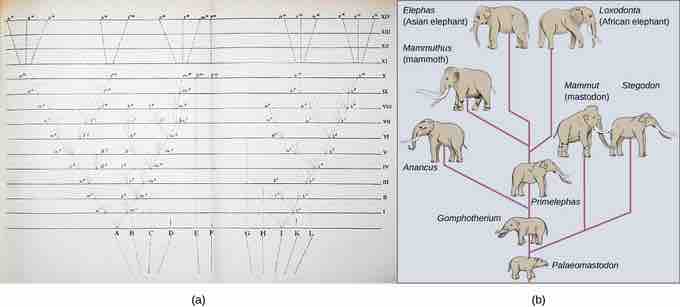Speciation
The biological definition of species, which works for sexually-reproducing organisms, is a group of actually or potentially interbreeding individuals. There are exceptions to this rule. Many species are similar enough that hybrid offspring are possible and may often occur in nature, but for the majority of species this rule generally holds. In fact, the presence in nature of hybrids between similar species suggests that they may have descended from a single interbreeding species: the speciation process may not yet be completed.
Given the extraordinary diversity of life on the planet, there must be mechanisms for speciation: the formation of two species from one original species. Darwin envisioned this process as a branching event and diagrammed the process in the only illustration found in On the Origin of Species, which bears some resemblance to the more modern phylogenetic diagram of elephant evolution . The diagram shows that as one species changes over time, it branches repeatedly to form more than one new species as long as the population survives or until the organism becomes extinct.

The Evolution of Species
The only illustration in Darwin's On the Origin of Species is (a) a diagram showing speciation events leading to biological diversity. The diagram shows similarities to phylogenetic charts that are drawn today to illustrate the relationships of species. (b) Modern elephants evolved from the Palaeomastodon, a species that lived in Egypt 35–50 million years ago.
For speciation to occur, two new populations must be formed from one original population; they must evolve in such a way that it becomes impossible for individuals from the two new populations to interbreed. Biologists have proposed mechanisms by which this could occur that fall into two broad categories: allopatric speciation and sympatric speciation. Allopatric speciation (allo- = "other"; -patric = "homeland") involves geographic separation of populations from a parent species and subsequent evolution. Sympatric speciation (sym- = "same"; -patric = "homeland") involves speciation occurring within a parent species remaining in one location.
Biologists think of speciation events as the splitting of one ancestral species into two descendant species. There is no reason why there might not be more than two species formed at one time except that it is less likely; multiple events can be conceptualized as single splits occurring close in time.